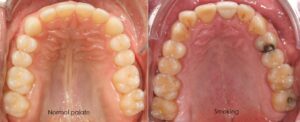Most of our patients can tell the difference in how their teeth and gums feel when they switch to a power toothbrush. Dr. Britten and his team can also typically tell when a patient uses an electric toothbrush versus a manual toothbrush – as there is usually a noticeable difference in the amount of plaque present as well as a patient’s gum tissue tone and color.
Improving oral health will improve overall health, a reason most patients will be happy to make the extra investment for a powerbrush. An electric toothbrush (our favorite professional-grade brands typically run from $150-200) is only a fraction of what it costs to complete most dental procedures. In the end, investing in a good power toothbrush, changing brush heads every 90 days, and using the proper technique will save you money!
Why choose a powerbrush?
Power toothbrushes usually have built in features with an advantage for better oral health.
Timer – Many brands feature a timer to ensure patients brush for a full two minutes, and may also have a pressure indicator to pause brushing or to let patients know if they’re brushing too hard and possibly damaging their gums. The Phillips Sonicare, one of our favorites, hesitates every 30 seconds, to help a patient distribute their brushing in all four sections of the mouth.
More effectively disrupts and removes harmful bacteria in the mouth. The sonic vibrating or oscillating of bristles from an electric brush remove sticky plaque bacteria effectively and stimulate the gum tissue, reducing inflammation. Electrics brushes operate at 30,000 strokes per minute while a manual is only 200 strokes.
Simpler technique. With a power toothbrush, all you have to do is move the brush from tooth to tooth, spending a few seconds at a time. The professional line of powerbrushes from Phillips Sonicare are definitely our favorite because they can penetrate below the gum line to disrupt the bacterial environment formed by plaque. Other brands, most notably the Oral B have brush heads that oscillate in a half-circle motion to remove biofilm (plaque) from the tooth surface.
Gentle and safe at the gumline. Using a powerbrush with the correct technique will help prevent gum recession, enamel abrasion (wearing away) and tooth sensitivity from improper brushing as well as tooth decay and gum disease. Even with their phenomenal power, power toothbrushes such as the Sonicare are still very gentle on the teeth and gums. If patients have gum recession, they can just place the brush on the tooth without using a scrubbing action, which can traumatize and wear away more thin and delicate gum tissue.
Stain removal. Electric toothbrushes help with stain removal, which is attractive to patients who really want a bright, white smile. Some Sonicare models come with a “whitening” setting or even special polishing brush heads.
Helps those with dexterity issues. Elderly patients or others with dexterity issues can also benefit from electric toothbrushes. Many patients can’t move their hands the way they need to, so if they use a manual brush, they’re likely leaving plaque behind. Powerbrushes help remove plaque from the teeth for them, so as long as they get it close to where it needs to be, it’s going to remove plaque and help prevent problems.
Great for kids. Electric toothbrushes are also great options for children, especially if they have braces!
Less time brushing, with a better result! In two minutes, a power toothbrush will remove plaque and massage and stimulate gum tissue more effectively than the minimum of four minutes you would need to brush with a manual toothbrush.
Proper Technique for Effective Power Toothbrushing
Divide your mouth into four quadrants. This can help ensure that you brush each section of your teeth and mouth cavity.
Place toothbrush bristles along gum line. Hold your toothbrush at a 45 degree angle to your gum line with a Sonicare or 90 degrees with an oscillating brush such as the Oral B. Applying gentle pressure, keeping the bristles in contact with your tooth surface and gum line, which can help ensure you get the most effective result possible. Stay on each area for a few seconds, moving the brush only when it is time to go to the next area. Once you’ve completed this procedure for a quadrant, move to the inner surfaces of your teeth and repeat the same procedure.
To brush behind your front teeth, tilt the brush vertically using only the front half of your brush. Clean biting surfaces, your tongue, and soft palate. This can help remove debris and other odor causing bacteria.




